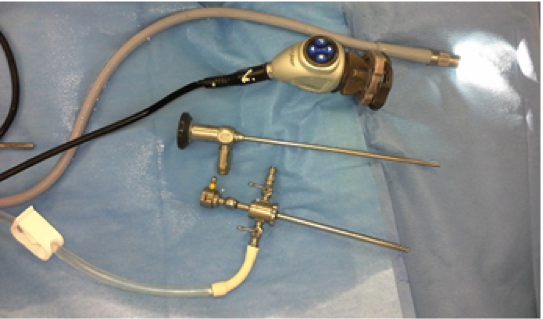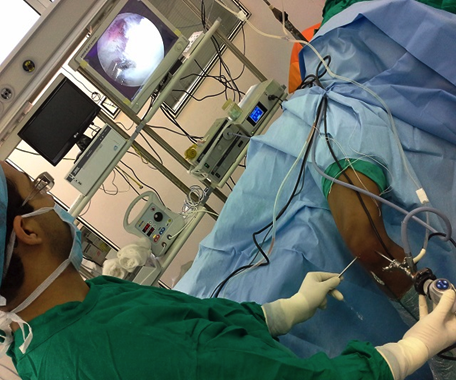Overview:
Arthroscopic surgery is minimally invasive procedure which is done to see inside the joint to diagnose and treat the joint disorders. In this surgery a tube like arthroscope is inserted into the joint via a key hole to see inside the joint. Arthroscope is attached to a camera and a light source to see inside the joint. It is done under anesthesia general or spinal. Prof Takagi (1888–1963) of Tokyo University was the first person who done diagnostic arthroscopy of knee joint in 1918. Today knee arthroscopy is one of the most commonly done orthopedic surgeries.
Prior to the widespread clinical use of arthroscopy and its specialized instrumentation, joint surgery required extended incisions for exposure and treatment of joint pathology. Arthroscopy offers several advantages over such extended open incisions. Compared with minimally invasive arthroscopic procedures, the extended exposure of joints prolongs recovery and increases pain and risk of complications, such as infection and stiffness. Minimally invasive surgeries, in general, result in less pain and postoperative swelling than open techniques. As a result, arthroscopically treated patients tend to heal faster and begin rehabilitation earlier and, subsequently, return to normal activity and work sooner.


Why arthroscopic surgery?
Advantages of arthroscopic surgeries over open surgeries:
- Small incisions and scars. Usually stab incisions are given for making portals which heal with minimal scarring
- Less postoperative pain
- Faster rehabilitation and faster return to work : Selected arthroscopic procedures can be performed under local anaesthesia
- Reduced hospital stay:
- Making the diagnosis: Diagnosis based on clinical examination alone is not always accurate, as the tests have certain limitations. Many a times, when the patient presents with an acute injury, due to pain clinical examination is virtually impossible. MRI too can give false positive findings. Arthroscopy is the gold standard in diagnosis of knee injuries.
- Reduced complication rate.
Indication
With the development of newer instruments and better understanding of the mechanism of injuries, the indications of arthroscopic surgery are on an increase. Knee is the commonest joint to undergo arthroscopic procedures, followed by shoulder, though virtually every major joint in the body (viz elbow, wrist, hip and ankle) are being ‘scoped’ for diagnostic and therapeutic purposes. The common indications for arthroscopic surgery of knee and other joints are listed below:
| Knee joint | Meniscal tear, ACL tear, PCL tear, Cartilage damage |
| Shoulder joint | Shoulder dislocation, frozen shoulder, rotator cuff tear |
| Ankle joint | Loose body removal, ankle pain due to impingement, cartilage damage |
| Elbow joint | Treatment for stiff elbow, loose body removal, Synovial biopsy, |
| Wrist joint | Wrist pain and instability due to Triangular fibrocartilage complex tear (TFCC), excision of wrist ganglion, synovial biopsy, radiocarpal fractures etc |
| Hip joint | labral tears, femoroacetabular impingement (FAI), snapping hips, loose bodies removal, synovial biopsy. |
Patient Preparation
Day before surgery you are admitted to hospital for some blood investigations, ECG and chest X ray. Most of the arthroscopic surgeries can be done under regional anaesthesia for which you have to be fasting for 8 hours before surgery. Hairs from the operating site are removed in the operation theatre before surgery.
Risks of Arthroscopic Surgeries
Usually they are very safe procedures. Apart from risks related to surgery and anaesthesia (infection, drug allergy, bleeding etc), complications of arthroscopic surgeries depend upon the specific arthroscopic procedure. Knee stiffness, numbness of leg after knee arthroscopy, and shoulder stiffness, nerve injury may occur after shoulder arthroscopy.
SPECIALITIES
OPENING HOURS
| Monday – Friday | 17:00 – 20:00 |
| Sunday | By Appointment Only |
+91-7357406805
CLINIC LOCATIONS
OUR PATIENTS SAY
We’re proud to receive some exceptional compliments from our patients and their family members. We fell very happy and blessed to see our patients recover.

मेरा दाए पैर में चोट लगने के कारण टेढ़ा हो गया था जिसकी वजह से मुझे चलने में भी परेशानी हो रही थी. डॉ जितेश ने ऑपरेशन कर के इसे सीधा किया. में बिलकुल ठीक हूँ .

Dr. Jain came out from his clinic to see my mother because my mother was not able walk a single step. He did total knee replacement on both side and now my mother is walking without aid.

मेरी बेटी के घुटने में इन्फेक्शन होने के कारण वो दर्द की वजह से सो भी नहीं पाती थी. डॉ जितेश ने ऑपरेशन कर के इसे ठीक किया. बहुत धन्यवाद।
